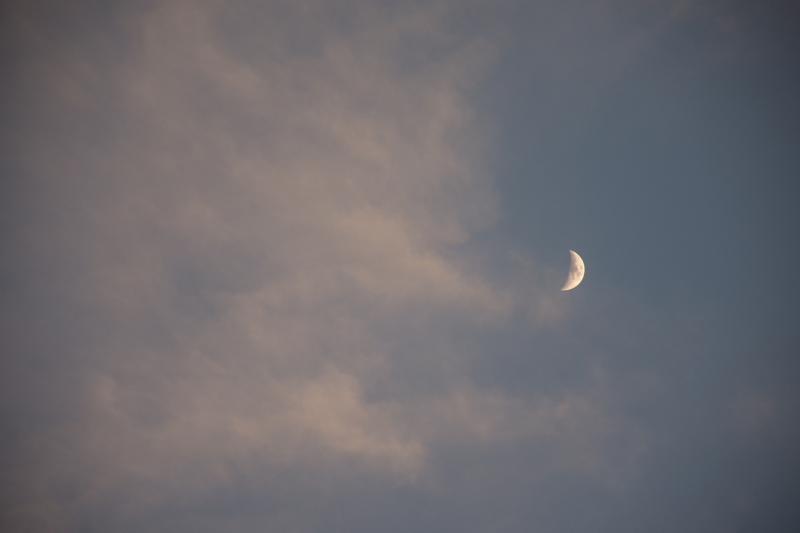Clouds, Moon, ISS (sort of)
Posted: 23 June 2015
|
Open: Monday, 22 June 2015, 1845 MST Temperature: 100°F |
Session: 842 Conditions: Partly cloudy, little smoke visible |
Monsoon season clouds approached the observatory from the south all during the daytime and were high in the southern sky as sunset approached. This photo shows the view to the south-southwest with the crescent Moon at the top right at 1853 MST:

The encroaching clouds would likely impact the imaging of the International Space Station (ISS) planned for the night. But I updated the ISS TLE anyway just in case I could see the pass.
1857 MST: viewed Venus, then Jupiter, and then the Moon, 83X. Since the clouds were now rapidly approaching the Moon I decided to grab a quick D7200 DSLR photo at prime focus, 1/500sec, ISO 1000:

I then did some brief lunar observing, 166X. 1905 MST: the clouds had reached the Moon. 1916 MST: clouds now at Venus. The last half of the ISS track was now in the clouds. 1926 MST: through a hole in the clouds viewed Jupiter and Venus using the 12x70 binoculars. The separation of the planets was just slightly greater than the 4.6° field-of-view (FOV) with the binoculars. They will both be in the same FOV on the next night.
1933 MST: clouds at the Moon, f/5.6, 1/160sec, ISO 400, FL 140mm:

1936 MST: monsoon clouds to south-southwest at sunset:

1937 MST: sunset. 1941 MST: did some more brief lunar observing, 166X.
Then slewed to the star Spica, which would be my focus test image target, clouds permitting. Mounted the D7200 DSLR on the 8" LX200-ACF at prime focus + 2X PowerMate. Confirmed good finderscope alignment. 1954 MST: did the focus test image using a Bahtinov Mask. All was now ready for the start of the ISS pass at 2014 MST. The clouds along the track were thin with a few thicker clumps. The space station would rise behind a tree against the still bright sky.
As the ISS was not visible at the start of the pass, I pressed the Enter key on the AutoStar keypad to start the telescope tracking on time. Oops, the Enter key got stuck in the "down" position. That made the AutoStar do a SYNC the location to the current coordinates. By the time I got the Enter key unstuck, the pass was well underway. I finally got the object centered in the finderscope and began tracking. After a few seconds I realized that the telescope was not changing orientation. I was "tracking" a star! I located the ISS in the sky and then began trying to slew the telescope to its rapidly changing position. By the time I caught up with the ISS the pass was half over. For the remainder of the pass tracking was bad, requiring continual manual corrections. And clouds frequently interferred with ISS visibility. Needless to say, the 1/2000sec, ISO 6400, HD video recording I did this night did not yield very usable images of the International Space Station. This is the best image from the video:

Yuck. Certainly not as good an image as my previous three ISS imaging sessions (images on the Satellites photo album).
2026 MST: after the ISS pass was over I saw and terminated two Kissing Bugs.
I asked the telescope to GOTO Saturn in the southeastern sky, but it ended up pointing to where the ISS pass started in the northwestern sky. That was the coordinates that the AutoStar inadvertantly SYNCed on. I manually slewed to the star Spica and SYNCed the AutoStar on it. After terminating Kissing Bugs #3 and #4, I did a GOTO Saturn again, which was placed in the 83X FOV. Will redo the AutoStar alignment on the next session.
Not a very good night at Cassiopeia Observatory. Closed up due to the clouds.
|
Close: Monday, 22 June 2015, 2046 MST Temperature: 83°F |
|
Comments are welcome using Email. If you are on Twitter you can use the button below to tweet this report to your followers. Thanks.
Cassiopeia Observatory Home Page
Copyright ©2015 Michael L. Weasner / mweasner@me.com
URL = http://www.weasner.com/co/Reports/2015/06/23/index.html
